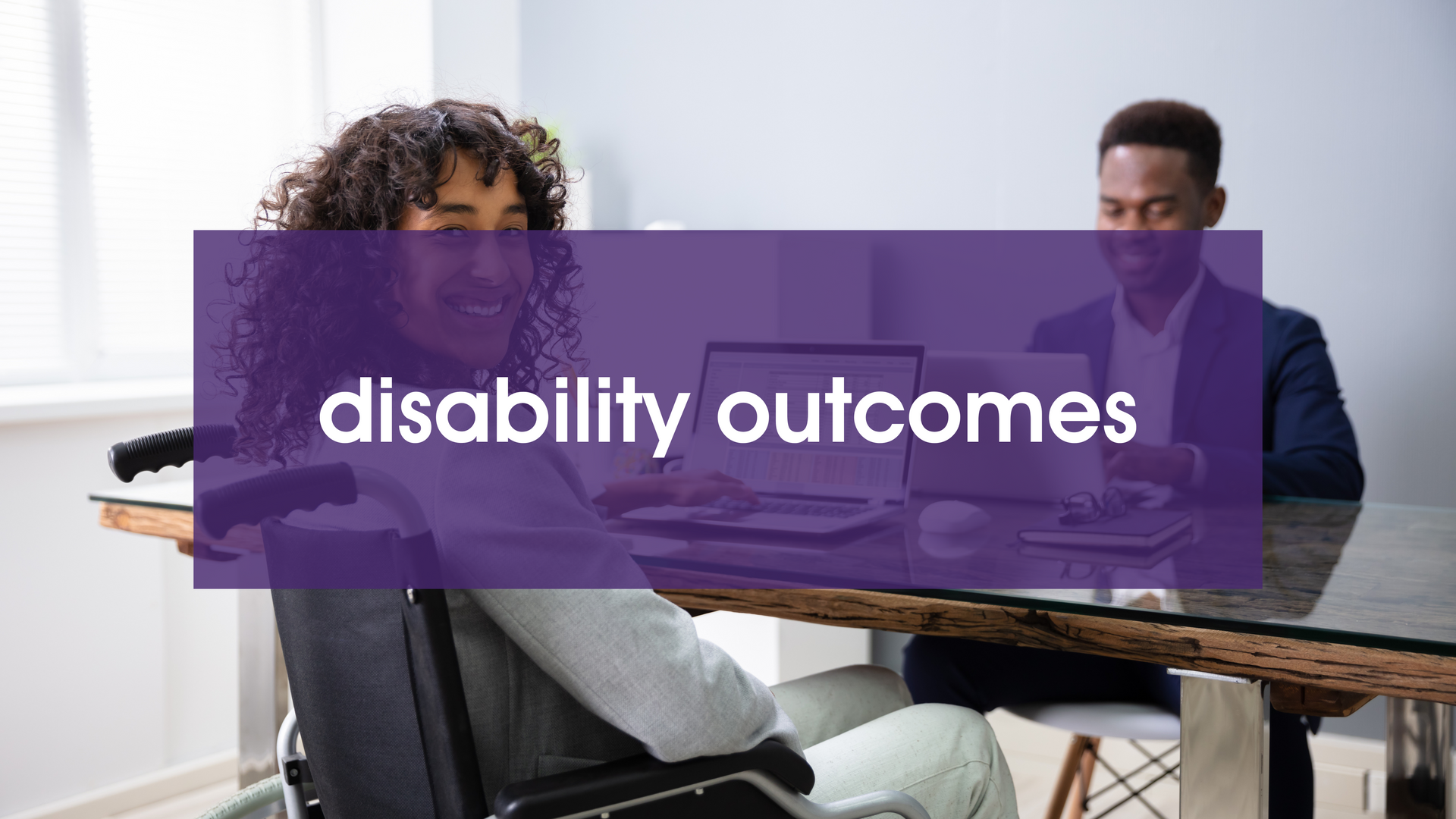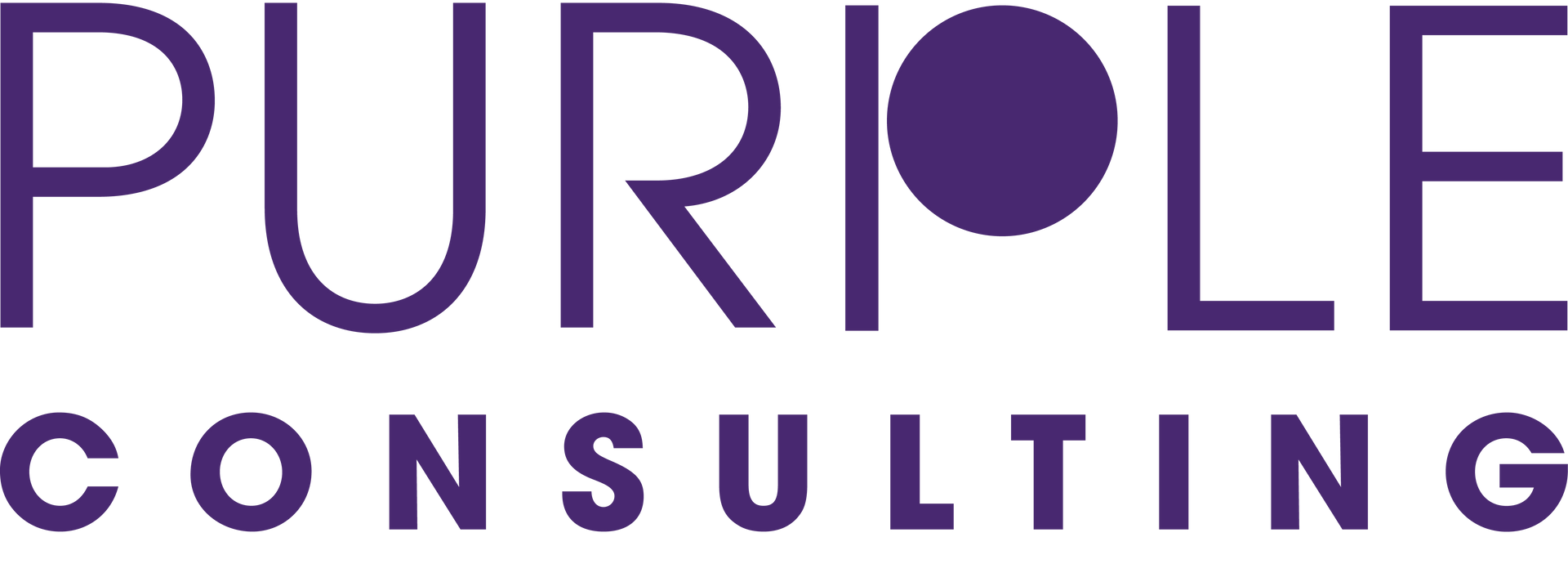
Your Introduction to Disability Inclusion: Concepts that Make a Difference
This article offers a concise introduction to essential disability concepts and definitions for anyone starting to explore disability inclusion.
The overview answers the following questions:
- How do we define disability?
- What are visible and invisible disabilities?
- What is the difference between The Social Model of Disability and The Medical Model of Disability?
- What are examples of the most common workplace barriers?
- Workplace adjustments: what are they and what are the most common misconceptions about them?
How do we define disability?
One in six people have a disability, making disability the world's largest minority group.
Understanding how disability is defined is important to knowing what it really means to build an inclusive environment for disabled employees in the workplace.
At Purple Consulting, we use the United Nations (UN) definition of disability, which is an all-encompassing definition that puts the onus on society to remove barriers, rather than fixing the person.
Here’s a short excerpt from The UN Convention on the Rights of Persons with Disabilities (CRPD), which protects all persons with disabilities:
"Persons with disabilities include those who have long-term physical, mental, intellectual or sensory impairments which in interaction with various barriers may hinder their full and effective participation in society on an equal basis with others."
The UNCRPD recognizes disability as an evolving concept that is influenced by social, cultural, and environmental factors, and emphasizes the importance of removing barriers and promoting accessibility to ensure the full participation and inclusion of persons with disabilities in all aspects of society. The convention also recognizes the diversity of disability and the need to promote respect for the rights and dignity of persons with disabilities.
As this definition demonstrates, disability is a broad term. It encompasses physical, mental, intellectual, and sensory impairments, therefore including long-term health conditions, mental health conditions and neurodiversity.
'Disability' occurs when any health condition or impairment interacts with various barriers and as a result, impacts a person’s life.
The extent to which a health condition or impairment impacts a person’s life will vary between the condition and even within the same condition. We will explore how to approach this further on in the article.
Invisible disabilities
Many of the disabilities included under this definition are invisible disabilities.
In fact, 80% of disabilities are invisible.
Most likely because of the way disability is portrayed in the media, disability is often thought to be something you can see, or something that is apparent when communicating with someone, such as someone using a wheelchair or someone who has a limb difference.
Invisible disabilities are less obvious and can’t be seen by just looking at someone. There are many different types of invisible disabilities, including:
- Chronic conditions such include Crohn’s disease, diabetes, chronic cough, and chronic fatigue.
- Chronic pain conditions, such as fibromyalgia and CERPS
- Autoimmune disorders, such as lupus or rheumatoid arthritis
- Mental health conditions, such as depression, anxiety, and bipolar disorder
- Neurological conditions, such as multiple sclerosis or epilepsy,
- Neurodivergence, such as ADHD and autism.
- Sensory disabilities, such as blindness and deafness.
While it’s important to acknowledge that many disabilities are invisible, the distinction between visible and invisible disabilities is not a perfect science.
Many of these invisible conditions will at times be more visible. For example, as a person with chronic pain, on a bad day, my disability would be visible – you would notice it in how I physically move.
The key though, is to recognise and understand the extent to which the above conditions or impairments impact a person's life and the extent to which people with these conditions face barriers in society.
There are two main models of disability that are important for everyone to understand, in particular those who want to be allies to the disabled community and play a role in reducing systemic barriers and inequity for disabled people. The word ‘model’ is used here to describe a way of thinking.
The Social Model of Disability and The Medical Model of Disability
The social model and the medical model of disability offer different ways of thinking about disability and different ways to solve the challenges people with disabilities face.
The medical model of disability says that disability is caused by a person’s impairment or condition. In other words, a person is disabled because of their condition /impairment. The medical model focuses on what a disabled person cannot do because of their condition or impairment. It emphasizes the limitations imposed on disabled people by their condition or impairment and seeks to address these limitations by "fixing" the disabled person, often through medical intervention.
There are several challenges with the medical model. Firstly, it creates negative attitudes towards disability – both in focusing on what a person cannot do, as well as focusing on needing to change the disabled person.
Secondly, the medical model avoids any accountability on society to create a world that is built for disabled people. We explore what this means below.
The social model of disability was developed by people with disabilities to challenge the medical model. The social model asserts that society creates barriers that disable people and that disability is not the result of a person’s condition or impairment. By shifting the responsibility for change onto society, the social model aims to create a world that is inclusive and accessible for everyone and puts the onus for change on society.
A disabled friend of mine put it simply:
‘If the world was built for disabled people, we wouldn’t be disabled’.
My personal experience of the medical and social model of disability
Before we explore the social model in action, it’s important to note while the social model is our preferred lens of disability at Purple Consulting, I believe there is still a place for the medical model. Neither are perfect and neither solely explain disability, therefore neither can be held in isolation.
The extent to which a disabled person experiences disability from either the lens of the social model, or the medical model, is a highly personal and experience, and there is no right or wrong. The key to being a great ally is to listen, validate and support each person in their unique experience.
From my personal experience of disability – some days I am disabled by my condition, other days I am disabled by society. As someone with fibromyalgia / chronic pain in my legs, there’s no denying that the pain at times disables me – it can make it very challenging to walk, sit and stand. This would align with the Medical Model of Disability.
However, I’ve come to realise how much societal norms and expectations also disable me. A real example of this is if I read a job description that states, ‘hybrid working – four days a week in office’. This instantly excludes me from that job – the inconsistencies of chronic pain prevent me from committing to driving into an office and sitting at a desk all day, 4 days a week. Luckily, I was afforded more flexibility in my work pattern at my last company, and I was able to thrive as a result.
I know, however, this is not always the case, and many disabled people face additional workplace barriers. We explore these below.
Systemic Change: Accessibility and Overcoming Workplace Barriers
Approaching disability from the lens of the social model can have a transformative impact on people with disabilities.
This fundamental shift in perspective opens up opportunities for meaningful, systemic change by putting the onus on society and workplaces to remove the systemic barriers. Approaching change from the perspective of the social model, revolutionises how organisations can address the most significant barriers for the participation of disabled employees, and achieve a desired outcome of accessibility for all.
Accessibility
In her book Demystifying Disability, Emily explains accessibility:
‘Accessibility is about making things more equitable so that disabled people have the same opportunities and support to thrive as do nondisabled people. It’s about removing barriers to participation, engagement, and understanding so that all people, regardless of ability, can experience the world around us to the fullest extent possible in ways that work for our minds and bodies.’
To achieve accessibility for all, and to make workplaces truly equitable for disabled people, we must overcome the most common workplace barriers.
Workplace barriers
Here is an outline of the most common barriers to accessibility that organisations may address in their Diversity, Equity & Inclusion (DEI) strategies::
1. Attitudinal barriers
Attitudinal barriers are negative feelings or beliefs held by individuals or society towards disabled people or disability in general. These beliefs may be both conscious and unconscious.
For example, some people may feel uncomfortable talking about disability or have misconceptions that disabled people are less capable or have limited potential. These are examples of attitudinal barriers that can make disabled employees feel excluded or undervalued. They may also prevent disabled employees from feeling less safe to talk about what they need to thrive in their roles, than non-disabled employees.
Other examples include negative stereotypes, such as the belief that disabled people need pity or sympathy simply because they are disabled – this may feel like a judgment on the value of someone’s life due to their disability. In the same vein, the sentiment of finding disabled people ‘inspirational’ for doing things that would not be deemed inspirational if a nondisabled employee were to do it – such as getting a promotion – could feel patronizing.
2. Communication barriers
Communication barriers occur when content, including digital content, is not accessible to people with disabilities, in particular people with hearing, sight, or speech impairments.
Communication barriers prevent the full engagement and participation of disabled employees, and they exist everywhere - the job application process, in internal comms and internal training, and via company LinkedIn posts and websites. Communication barriers include:
- Lack of closed captions in all video content, lack of sign language interpretation for video and live content, and lack of speech-to-text software – making communications inaccessible for deaf or hearing-impaired employees.
- Lack of use of alt text in all images, lack of image description and lack of access to screen-reader technology for people who are blind or visually impaired.
- Websites not adhering to WCAG guidelines, which clearly identify ways to make a website accessible.
3. Physical barriers
Physical barriers are those caused by a lack of accessible built environment.
From a workplace perspective, the biggest barriers exist when offices and other work sites, car parks and associated transport are not built with disabled people in mind. Physical barriers include a lack of accessible toilets, accessible parking, and corridors that are too narrow for wheelchair users. Physical barriers also include not providing a quiet space or low-lit area for people to decompress from sensory overload.
4. Lack of support and workplace accommodations
In many ways, being a great disability inclusive leader is no different to being a great people manager.
Showing empathy, asking how you can support a disabled employee, and creating a psychologically safe culture for employees to request accommodations, are the same as the leadership skills required to support all employees. Good leaders know how the employee works best, what makes them tick and how to support them.
As someone recently responded on a LinkedIn post I shared on What Actually is DEI:
‘DEI is basic human decency’. I tend to agree.
To achieve accessibility for all, and to remove barriers that prevent them from performing at their best, some disabled employees require workplace accommodations.
Workplace accommodations, also known as workplace adjustments, help to remove workplace barriers and make the workplace more equitable for people with disabilities. These can come in many forms, including providing assistive technology or adaptive equipment, offering flexible work patterns, and providing training or mentorship to support disabled employees to develop their skills.
Two Common Misconceptions About Workplace Accommodations
1. Accommodations are expensive.
Whilst some accommodations do have a cost, the reality is that many are free, such as offering a flexible work pattern or ensuring all videos have closed captions. It is hard to get a precise average cost of an accommodation, and estimates do vary, but the Business Disability Forum in the UK suggest that the average cost of an accommodation or adjustment is less than £180 [1]. I expect this is less than many companies might predict.
2. Accommodations are special treatment.
It’s vital to note that accommodations and adjustments are not special treatment. They are simply ways to level the playing field and provide equal opportunities for people with disabilities to participate and succeed in the workplace.
In her book Positively Purple, Kate Nash says ‘Workplace adjustments are our lifeline’. This sentence has stuck with me. If you could put accommodations in place that make a significant difference in disabled employees' lives and productivity, with a few simple measures, wouldn’t that be worth doing?
In many countries, including the EU, USA, Canada, and Australia, adjustments and accommodations are required by law.
Bringing together the Social Model of Disability and Removing Barriers
By now I hope you have a good understanding of the social model and an understanding of some of the most common workplace barriers.
When we bring the two together, we can recognise that it is the responsibility of society, and not the disabled person, to remove barriers and create accessible environments.
The workplace offers employers a significant opportunity to promote inclusivity and equity for people with disabilities. This can have a massive knock-on effect on society and at Purple Consulting, we believe it is an untapped frontier for corporate social responsibility.
Conclusion
From exploring the Social and Medical Model of Disability, and speaking to disabled people, I believe that one simple question can make a huge difference:
What are you disabled by and how can we make our workplace accessible to you?
Not all questions are created equally and this question seeks to understand the experience of disabled employees. It can be broken down further with inquiries like:
- What barriers do you face daily in our business that inhibit you from thriving in your role?
- What can I do to remove those barriers, and how will we know when they have been removed?
The better we understand our disabled employees, the more we can be allies, work to remove systemic barriers and support our disabled colleagues at work. We may even end up changing the world for the better.
If you would like to look closer at your DEI strategy and how to address disabled inclusivity, get in touch here.
1.
Where to Start with Disability Inclusion - BDF (businessdisabilityforum.org.uk)
New Paragraph


All Rights Reserved | Purple Consulting

